4 HMO Stocks to Watch Amid Persistent Industry Challenges
The U.S. health insurance industry, referred to as Health Maintenance Organization (“HMO”), is expected to benefit from a growing customer base that fetches a consistent flow of premiums for industry players. Possible interest rate cuts in 2024 are expected to make way for rebounding merger and acquisition (M&A) deals. Though technology investments are made to boost operational efficiencies, they often escalate costs and erode margins for these players. A shortage in the availability of medical personnel across the United States continues to be a concern. Despite the challenges, companies like UnitedHealth Group Incorporated UNH, The Cigna Group CI, Centene Corporation CNC and Humana Inc. HUM appear well-placed to counter industry headwinds.
About the Industry
The Zacks HMO industry consists of entities (either private or public) that take care of subscribers’ basic and supplemental health services. Companies in this space primarily assume risks and assign premiums to health and medical insurance policies. Industry participants also provide administrative and managed-care services for self-funded insurance. Services are generally offered by a network of approved care providers (called in-network), which include primary care physicians, clinical facilities, hospitals and specialists. However, out-of-network exceptions are made during emergencies or when it is necessary. Health insurance plans can be availed through private purchases, social insurance or social welfare programs.
4 Trends Shaping the Fate of the HMO Industry
Elevated Technology Expenses: Telehealth services were prevalent in the United States prior to the COVID-19 pandemic, but their usage was not as widespread as it has been since the onset of the pandemic. The convenience and affordability of these services send a clear indication of the same continuing to stay in high demand in the days ahead. To stay up-to-date with the ongoing digital trend, the HMO players are compelled to undertake technology investments to build telehealth platforms. The platforms undoubtedly attract more customers and fetch a steady revenue stream for industry players. However, the technology advancements undertaken in relation to such platforms require significant expenses. This may erode the margins of health insurers.
A Scarcity of Medical Staff: A shortage of nurses and other medical personnel continues to be a nationwide concern, which is taking a toll on the efficient functioning of hospitals as they have to treat a growing number of patient volumes. An increase in the number of nurses reaching retirement age, a higher burnout level and inequitable workforce distribution are some of the factors triggering a scarcity in the nursing workforce. Health insurers collaborate with hospitals, physicians and other facilities to offer discounted care access to plan members. The effectiveness of services remains a crucial factor behind the renewal of a health insurer’s health plan. A shortage in the nursing workforce can reduce a hospital’s ability to deliver quality care services and indirectly affect the customer base of HMO companies.
Rising Membership: Most of the participants in the HMO space distribute cost-effective health plans and upgrade them with some eye-catching features from time to time. The strength of such plans continues to fetch federal or state contract wins for HMO players, which serves as a means to boost membership growth. A steady membership growth brings continual improvement of premiums, the most significant top-line contributor of a health insurer. Given an aging U.S. population, the solid demand for Medicare plans (meant for 65 years and above) distributed by health insurers is expected to remain on an uptick in the days ahead. However, persistent inflationary headwinds can exert strain on uninterrupted healthcare premium payments by customers.
Active M&A Moves: Apart from technology investments, an M&A strategy is often pursued by the industry players to advance their capabilities, enter new regions, delve deeper into existing ones, grow their customer base and solidify their nationwide presence. These initiatives also aim to bring diversification benefits, which are in dire need to sustain one’s competitive edge. As the Fed points to interest rate cuts in 2024, borrowing costs are expected to witness a decline, thereby making it easier for industry participants to opt for loans to enter M&A deals and avoid complete exhaustion of cash reserves. After facing a roadblock in 2023, M&A activities are expected to rebound in 2024, per Morgan Stanley Investment Banking.
Zacks Industry Rank Indicates Bearish Outlook
The group’s Zacks Industry Rank, which is basically the average of the Zacks Rank of all member stocks, indicates tepid near-term prospects. The Zacks Medical-HMOs industry is housed within the broader Zacks Medical sector. It currently carries a Zacks Industry Rank #196, which places it in the bottom 22% of more than 250 Zacks industries.
Our research shows that the top 50% of the Zacks-ranked industries outperform the bottom 50% by a factor of more than 2 to 1. The industry’s positioning in the bottom 50% of the Zacks-ranked industries is a result of the negative earnings outlook for the constituent companies in aggregate.
Despite the dismal scenario, we will present a few stocks that one can buy or retain, given their solid growth endeavors. But before that, it is worth looking at the industry’s recent stock-market performance and the valuation picture.
Industry Underperforms S&P 500 But Outperforms Sector
The Zacks Medical-HMO industry has inched up 1.6% compared with the Zacks S&P 500 composite’s 24.5% growth and the Zacks Medical sector’s rally of 0.8% in the past year.
One-Year Price Performance
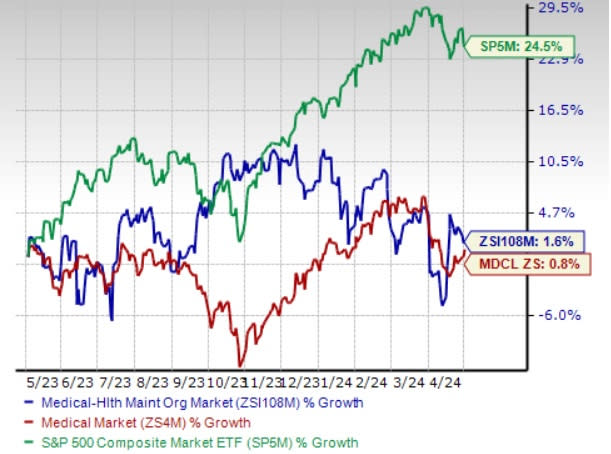
Image Source: Zacks Investment Research
Industry's Current Valuation
On the basis of the forward 12-month price-to-earnings (P/E) ratio, which is commonly used for valuing medical stocks, the industry trades at 15.21X compared with the S&P 500’s 20.21X and the sector’s 23.16X.
In the past five years, the industry has traded as high as 19.57X and as low as 11.79X, the median being 15.99X, as the chart below shows.
Forward 12-Month Price/Earnings (P/E) Ratio

Image Source: Zacks Investment Research

Image Source: Zacks Investment Research
4 Stocks to Watch
We present four stocks from the space with a Zacks Rank #3 (Hold). Considering the current industry scenario, it might be prudent for investors to retain these stocks in their portfolios, as these are well-placed to generate growth in the long haul.
You can see the complete list of today’s Zacks #1 Rank (Strong Buy) stocks here.
UnitedHealth Group: Based in Minnesota, UnitedHealth Group gains on solid contributions from UnitedHealthcare and Optum businesses. Affordable Medicare and Medicaid plans are distributed through the UnitedHealthcare unit. In contrast, the Optum unit gains on buyouts and utilization of advanced technology, market-leading health analytics, modern care delivery and data-driven population health approaches. A robust telehealth services suite developed through significant investments enables UNH to deliver virtual healthcare services effectively.
The Zacks Consensus Estimate for UnitedHealth Group’s 2024 earnings is pegged at $27.60 per share, indicating a 9.9% rise from the 2023 reported figure. UNH’s earnings beat estimates in each of the last four quarters, the average being 3.65%.
Price & Consensus: UNH
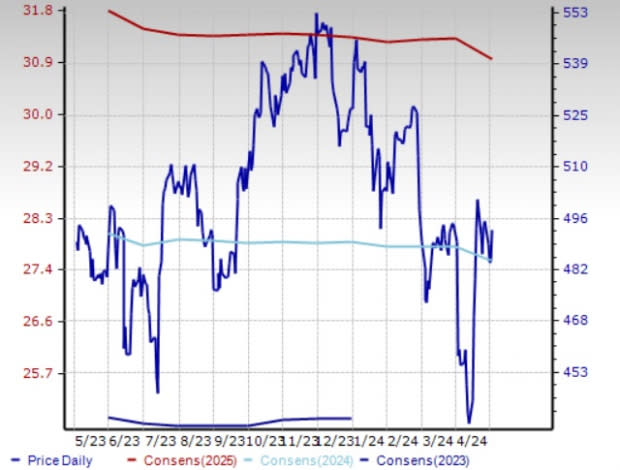
Image Source: Zacks Investment Research
Cigna: This Connecticut-based health insurer continues to benefit on the back of its two growth platforms, namely Evernorth and Cigna Healthcare. While a solid specialty pharmacy services suite drives the growth of the Evernorth platform, the Cigna Healthcare unit benefits from a growing customer base. It forecasts to achieve average annual adjusted EPS growth of 10-14% in the long term.
The Zacks Consensus Estimate for Cigna’s 2024 earnings is pegged at $28.36 per share, implying 13% growth from the 2023 reported figure. CI’s earnings outpaced estimates in each of the last four quarters, the average being 3.29%.
Price & Consensus: CI
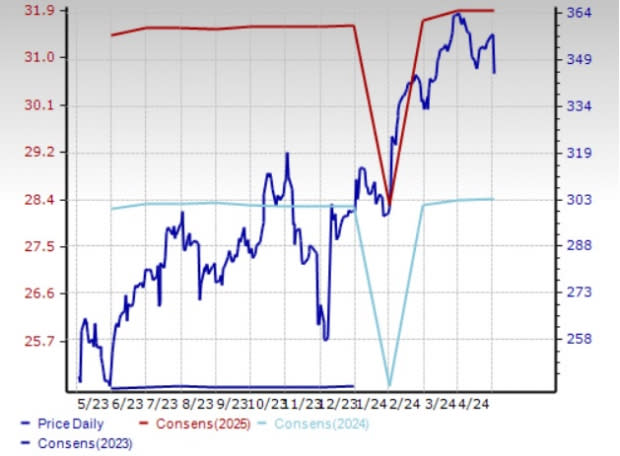
Image Source: Zacks Investment Research
Centene: The Missouri-based company benefits on the back of a strong customer base in its Medicaid and Medicare businesses. This year, it got Medicaid contracts from the Michigan Department of Health and Human Services and the New Hampshire Department of Health and Human Services. Premium and service revenues are estimated within $135.5-$138.5 billion for 2024.
The Zacks Consensus Estimate for Centene’s 2024 earnings is pegged at $6.80 per share, indicating a 1.8% rise from the year-ago reported figure. CNC’s earnings surpassed estimates in each of the last four quarters, the average beat being 10.45%.
Price & Consensus: CNC
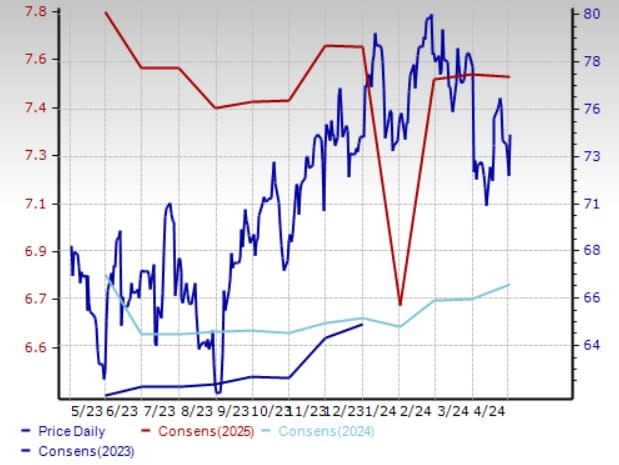
Image Source: Zacks Investment Research
Humana: Headquartered in Kentucky, Humana is driven by higher premiums and an expanding customer base across its Medicaid and Medicare businesses. It received a Medicaid contract from the Oklahoma Health Care Authority. HUM also takes care of the nationwide elderly population through its CenterWell brand. A series of acquisitions undertaken diversified income streams of HUM.
The Zacks Consensus Estimate for Humana’s 2024 earnings is pegged at $16.18 per share. HUM’s earnings surpassed estimates in three of the last four quarters and missed the mark once.
Price & Consensus: HUM
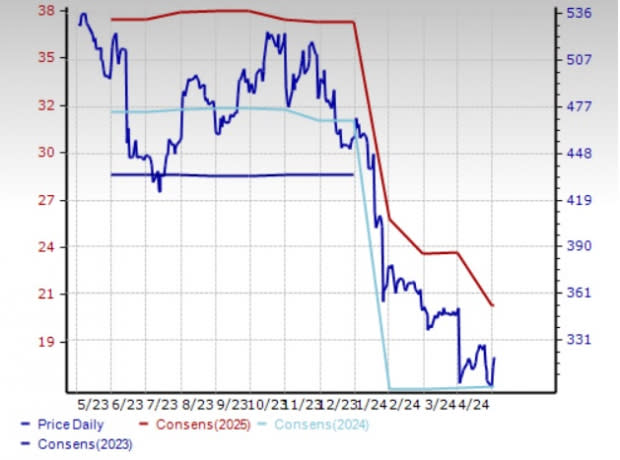
Image Source: Zacks Investment Research
Want the latest recommendations from Zacks Investment Research? Today, you can download 7 Best Stocks for the Next 30 Days. Click to get this free report
UnitedHealth Group Incorporated (UNH) : Free Stock Analysis Report
Humana Inc. (HUM) : Free Stock Analysis Report
Cigna Group (CI) : Free Stock Analysis Report
Centene Corporation (CNC) : Free Stock Analysis Report

 Yahoo Finance
Yahoo Finance 